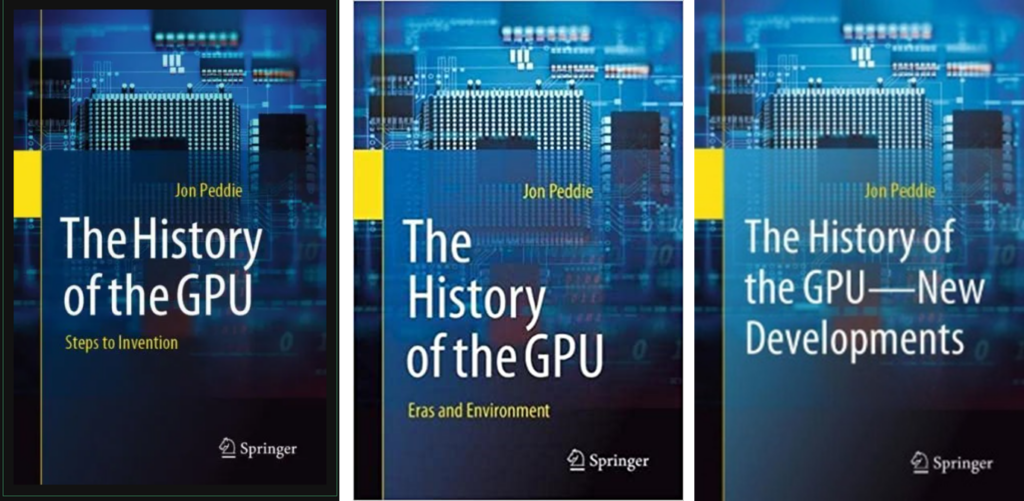In 1998, the PC graphics industry reached a peak, with 47 companies offering or designing graphics chips, driven by the growing popularity of PC gaming and multiple monitor setups. Graphics controllers added 3D capabilities, and transform and lighting (T&L) were introduced, although DirectX 6 did not fully support those features. VideoLogic (later Imagination Technologies) pioneered tile-based deferred rendering (TBDR), which saved memory and bandwidth by capturing and rendering the entire scene as tiles. This innovation influenced the development of future graphics technologies, but competition from companies like Nvidia led to Imagination’s shift toward mobile graphics.
The Imagination Technologies Kyro
1998 was a high mark in the PC graphics industry. As the Internet bubble peaked, 47 companies were offering or designing graphics chips for the PC. The market had gone to 130 million units, shipped to more than PCs, as gamers, engineers, and programmers put two graphics add-in boards (AIBs) into their PCs for more power and to drive multiple monitors. It was an exciting and perilous time and a significant inflection point in the industry.
Graphics controllers were adding 3D capabilities, and transform and lighting (T&L) was offered as a graphics coprocessor and headed for integration into the graphics chip. DirectX 6 had just been introduced but didn’t support T&L or the new pipeline engine being called a shader.
The high-bandwidth AGP bus was introduced in the fall of ’97.
The big boys in the graphics chip business were 3dfx, ATI, Nvidia, and S3. The Tier 2 companies were IBM (the former leader), Matrox, Number Nine, Rendition, Trident, and VideoLogic.
Simultaneously, the leadership in the console market was shifting, as it was in the workstation segment as well. Intel was about to announce the 486, the first CPU with a built-in floating-point processor (FFP) and an extended pipeline. Also, in 1998, SGS Thomson, Nvidia’s original fab partner, changed its name to STMicroelectronics (STMicro) and switched to being VideoLogic’s fab partner. Almost all the norms in the industry were changing.
By 1999, things were changing even faster. The Internet bubble was deflating, and venture capital for start-ups and existing companies looking for a second or third round dried up.
In August 1999, DVI was introduced, and in September 1999, VideoLogic changed its name to Imagination Technologies.
The number of graphics chip suppliers fell to 31 as the Internet bubble crashed, and by 2000, there would only be 15 suppliers.
VideoLogic introduces tile-based deferred rendering
VideoLogic was founded in 1985 and was a pioneer in offering multimedia—audio, graphics, and video.
In 1992, the company started the Trident Project to develop tile-based deferred rendering (TBDR). The company established the PowerVR division in 1994 and introduced the PowerVR tiling architecture with TBDR.
PowerVR used display-list rendering, batching polygons before rendering them. Typically, a graphics controller, accelerator, or GPU would draw polygons individually. PowerVR’s TBDR architecture captures the whole scene before starting to render. It then sorts through the image, identifying occluded pixels and rejecting them before processing them. A block diagram of the TBDR pipeline is shown in Figure 1.
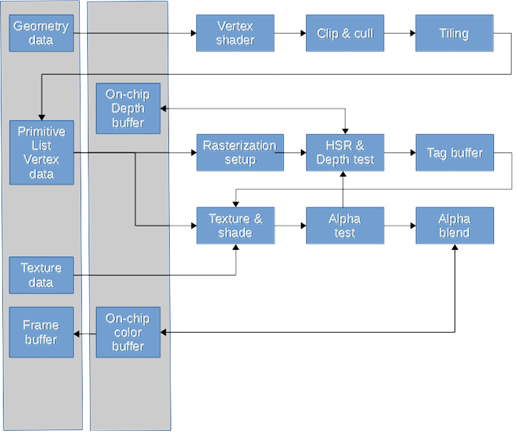
In the case of other graphics controllers or accelerators, triangles get sent in any order to the controller, and the z-buffer decides on a pixel level which polygon will appear in front of others. This standard method requires a random-access z-buffer with the same X-Y dimensions (or greater) as the screen.
If you could watch a scene generated (a single frame in less than 33ms), you would see the image created polygon by polygon. If you could see the same scene drawn by the PowerVR, the picture would fill in with tiles, left to right, top to bottom. Thanks to that method, VideoLogic could eliminate the external z-buffer, thereby saving memory and memory bandwidth, and costs. Imagination presorted the polygons from back to front. It then ignored (deferred) the polygons that were behind other polygons.
The technique of deferred rendering is also known as chunking. Chunking improves performance by using special situation knowledge to aggregate related memory allocation requests. For example, if it was known a specific type of object was required in groups of eight, instead of allocating and freeing each object individually, making 16 calls to the heap manager, one could allocate and free an array of eight of the objects, reducing the number of calls to two.
The PowerVR PCX series
At the end of 1995, VideoLogic developed the first chip in the PowerVR series, code-named Midas 3. It included an image signal processor (ISP), code-named Sabre, and Texture and Shading Processor (TSP), code-named TexAS, as well as a PCI and memory bridge chip.
VideoLogic delivered its first integrated chip, the PCX-1, and introduced the brand PowerVR in the second half of 1996. The initial target for PowerVR Series1 was arcade systems, and VideoLogic licensed its new chip to NEC. To ensure priority delivery, NEC invested in VideoLogic and obtained 2.29% of the company’s shares.
The ISP was scalable, and two or four ISPs were used in arcade machines. The PC version uses a three-chip structure with a single ISP and TSP configuration.
VideoLogic was trying to supply graphics boards to two markets: arcade machines and PCs. With NEC’s connections and backing, VideoLogic did well, especially in Japan. The competition in the PC market was fiercer and had a different culture that was based on supply and price, and less on relationships.
However, the unit volume of the PC market was more significant than the arcade markets and growing, whereas the arcade market was entering into a no-growth phase followed by a decline as home consoles and PCs took over.
Seeing the PC market growth and assessing the suppliers’ offerings and capabilities against the technological needs of the market for the next few years, VideoLogic undertook the development of what could have been the killer graphics chip.
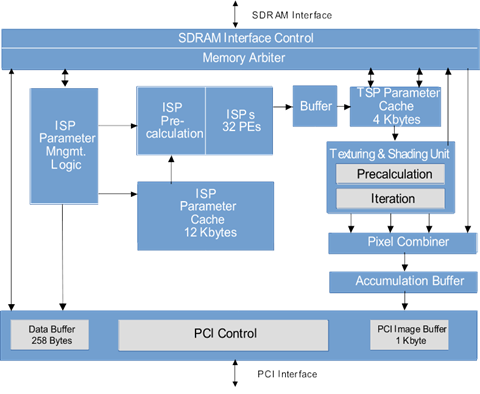
VideoLogic successfully sold the PCX-1 to PC AIB suppliers like Matrox and Tseng Labs, and PC suppliers like Compaq and Gateway. Those companies helped establish VideoLogic’s name as an important graphics chip developer in the PC market.
In 1996, Sega launched two development teams—one in Japan and one in California—to compete in developing the next-generation home console, the Dreamcast. All the graphics chip companies vied to be the supplier, and Nvidia, which even had a development contract with Sega, thought they had won. The California Sega design team dropped Nvidia and chose 3dfx. Then later, Sega announced that the Japanese team had won and would use NEC’s VideoLogic chip.
3dfx engaged in a legal battle with Sega and NEC (with VideoLogic) over technology disputes. VideoLogic distanced themselves from the drama, leaving it to NEC and Sega to handle. The trial got marked by personal attacks and insults, which attracted media attention. VideoLogic later revealed that Sega chose NEC for political reasons, and Sega confirmed that 3dfx’s version had no future. The trial concluded with Sega agreeing to pay a $10.5 million settlement. The whole story can be found in Jon Peddie’s The History of the GPU – Steps to Invention.
After developing the PowerVR PCI-2 (code-named Highlander) and trying to sell the Neon 250 PC AIB version of it, the company, now called Imagination Technologies, quietly stopped pushing it and instead concentrated on the next-generation design, which it planned to jump a generation of what other companies were going to offer.
The reviews of the Neon 250 were merciless, approaching cruel. One reviewer wrote, “The Neon 250 is a big fat blunder in the shape of a video card.”
STMicro PowerVR3 and Kyro
Development on the next-generation chip, called Kyro, began in 1999, just as the PC graphics market was growing and the Internet boom was starting its decline.
VideoLogic laid the foundation for re-entering the PC graphics industry in April 1999, after the embarrassment of its failed Neon 256 product. The company announced this by signing STMicroelectronics (aka STMicro, STM, or just ST) for its PC products as its new fab and partner for PC graphics.
The company was moving from NEC to STMicrosystems. NEC Electronics and ST said they would pursue different market segments, working independently on respective PowerVR road maps. The VideoLogic and NEC relationship would continue on other fronts, including gaming consoles and VideoLogic’s lucrative arcade gaming machines business, including Pacheco and casino machines. ST will combine its set-top and consumer TV expertise, combining its technology with VideoLogic’s PowerVR graphics core for both PCs and consumer appliances.
NEC licensed and manufactured the first two generations of VideoLogic graphics accelerators, Series 1 and Series 2.
Going forward, VideoLogic said it would build and sell the Series 3 parts, which were planned to be produced later that year.
The announcement drew mixed reactions from the industry.
“It clearly made sense to focus on the Dreamcast activity,” said Hossein Yassaie, CEO of VideoLogic. “From a planning point of view, we’ve retargeted that product to be more cost-effective.” Hossein declined to comment further on the cost reduction.
The VideoLogic Series 2 parts run at 125MHz and provide similar performance to those of competitors using faster 175MHz parts. Those efficiency advantages led to ST’s commitment to VideoLogic for its graphics architecture of the future, explained Tim Chambers, vice president and general manager of ST’s Graphics Products Division.
“If an architecture requires 200MHz large frame buffers, then that will impact the system cost on the desktop,” Chambers said. “Everything else equal, PowerVR is very good, even with the smaller 64-bit frame buffer interface.”
According to Yassaie, the market may likely see Series 3 parts from both NEC and ST, but with different feature sets and capabilities and for different markets. Although Chambers said he didn’t envision direct competition between the two companies, he didn’t rule out the possibility.
“We still have a relationship with NEC,” Yassaie said, citing the company’s strategy of developing partners to define products, as both VideoLogic and ST will do. Both companies declined to discuss features of the Series 3 parts, but ST’s Chambers said the parts will be fabricated in an 0.18-micron process, either by ST or a third-party foundry.
VideoLogic’s decision would have a domino effect because ST also had an ongoing relationship with Nvidia. ST’s Chambers, an affable and dexterous diplomat, at the time said ST’s deal with VideoLogic had reached “a natural end of its relationship” with Nvidia. ST had been instrumental in helping Nvidia and built the first products for the company. The opportunity, or the deal, to work with VideoLogic over Nvidia must have been very powerful. ST produced the Nvidia controllers from the NV1 to the Riva 128, one of Nvidia’s most successful products.
Chambers praised PowerVR’s unique architecture and visual quality on Sega’s Dreamcast and Naomi arcade systems, emphasizing its algorithmic approach to 3D processing eliminated redundant processing and memory bottlenecks. Additionally, noted Chambers, PowerVR kept as much processing as possible on-chip, minimizing the frame buffer requirements and bandwidth cost of accesses to off-chip memory—a growing requirement for competitive solutions.
Yassaie said, “ST’s excellence in manufacturing, process technology, and the video graphics market are a significant new asset to PowerVR and will further extend the availability of this innovative technology to its widest ever PC audience. The combination of ST’s strengths and VideoLogic’s PowerVR technology will give PC users everywhere access to the best in 3D graphics.”
ST said it would continue to manufacture the Nvidia Riva 128 controllers if there is demand but emphasized its 1999 road map with new 3D controllers would solely be based on the PowerVR.
“The relationship with STMicro,” said Trevor Wing, Imagination’s VP of marketing, “is more than just a fab—they’re the sales channel.” Given STMicro’s experience with the selling of Nvidia’s Riva, the company will be the first to ship the Series 3, and they have input into the design. STMicro has its own blocks and 250nm experience, he added.
In August 1999, VideoLogic reorganized and changed its name to Imagination Technologies and continued working on the third-generation designs.
PowerVR3 STG4000 Kyro—2001
In June 2000 at Computex Tapai, Imagination announced Kyro and the VideoLogic Vivid AIB. Imagination’s third-generation PowerVR3 (STG4000) Kyro was released by ST in 2001.
128-bit GUI acceleration (2D part) includes:
- Three-operand ROPs
- Clipping
- Color expansion
- Bit-block operations (BitBLT): transparency and stretching
- Optimization of the pipeline provided protection against dropping out operations with 24-bit screen depth
- All 2D operations were performed in hardware, including mono color expansion, point, and line drawing
The graphics accelerator’s architecture had been redesigned and expanded to a dual-pipeline design for more performance and better game compatibility.
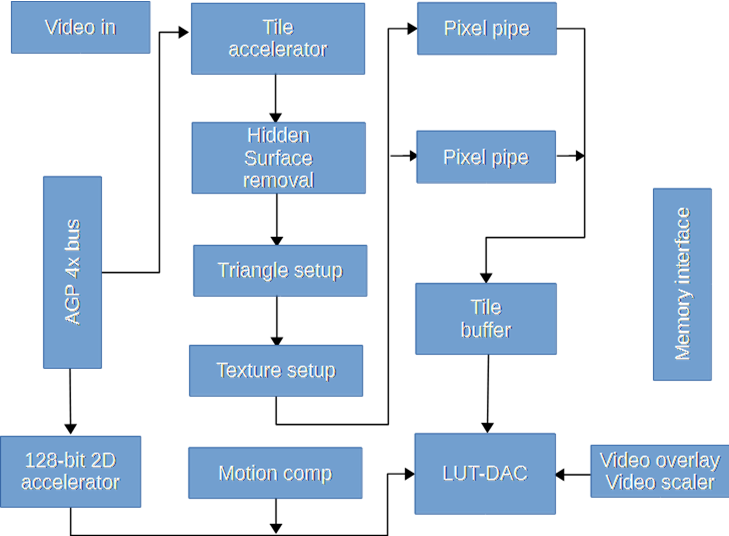
The chip was announced with OpenGL 1.1 and DirectX 8, though it only fully ran DirectX 6 features (with partial support for DirectX 7). Versions with 64MB were announced, as was an exchange program for PCX or Neon 250 cards, but it never materialized. However, the chip failed to attract any big-name AIB suppliers.
PowerVR3 STG4500 Kyro II—2001
The PowerVR3 Kyro II was process shrink, from 250nm for Kyro I to 180nm for Kyro II. That improved clock rates and memory bandwidth.
The Kyro II specifications:
- 180nm manufacturing process
- 175MHz controller clock (synchronized with the memory)
- 128-bit memory bus, up to 64MB SDR
- Tile rendering architecture with 32×16 pixel tiles
- Two-pixel pipelines. Each one has one texture unit
- Capable of blending up to eight textures in a single pass
- Independent filtering of each texture (anisotropic, bilinear, and trilinear, up to 16 samples)
- Full-screen anti-aliasing without increasing the frame buffer size
- Rendering of just visible textured pixels, eliminating need to store depth values— the fill rate was equal to 350 million pixels per second
- AGP 1x/2x/4x interface
- TDMS transmitter DVI interface
- A hardware T&L block was not present
The 3D part included hardware capabilities such as:
- A mechanism for full preparation of triangles and texturing/shading parameters: removing hidden surfaces, shading, and texturing where all scene parameters are stored in local memory, which reduces the load on the processor and the interface bus
- Flexible DirectX 7 vertex format; however, there was no mention of DirectX 8 support
- OpenGL ICD support
- Eight-layer multitexturing with unique features
- A DLR (display-list renderer) mechanism to split the entire scene into separate sections
- Gouraud RGB shading and specular overlay
- Texture filtering, including bilinear, trilinear, and anisotropic filtering algorithms
- Color dithering and texture alpha blending
- Tabular and vertex fogs
- Texture compression
- Bump mapping: Environment-mapped bump mapping (EMBM), embossed bump mapping, and perturbed UV bump mapping (aka dot product)
One of the first AIB suppliers to sign up for the new chip was the venerable Hercules Corporation, which introduced the 3D Prophet 4000XT (Figure 4). It became a popular AIB and helped extend Hercules’ marginal life.
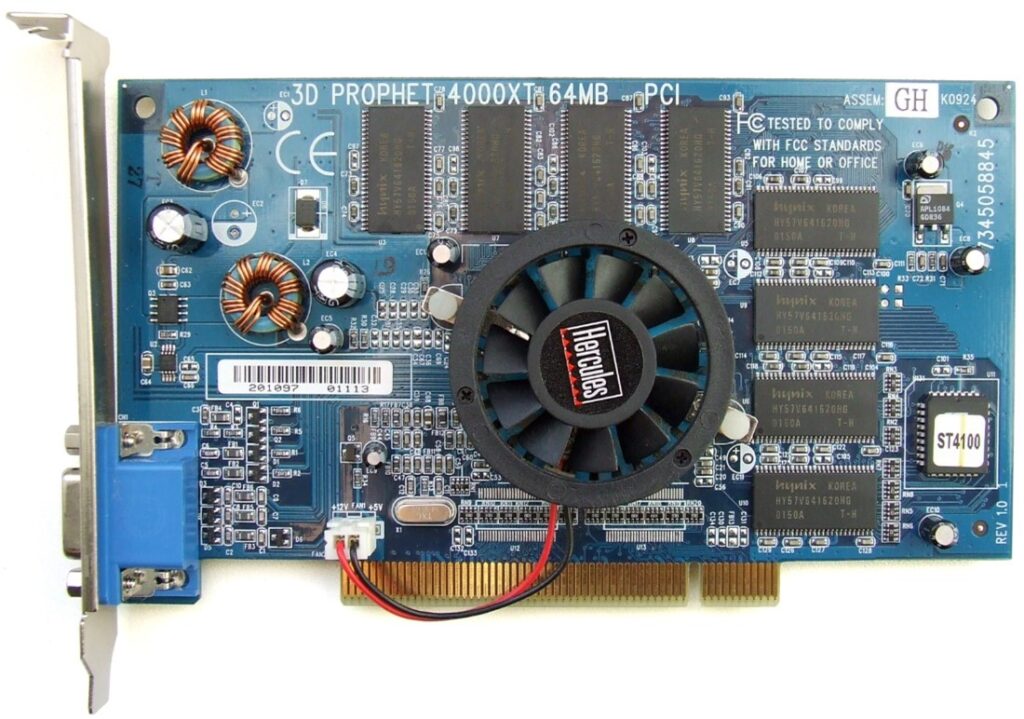
However, few other AIB companies used the part, and it was seen as a stopgap product. This was now the era of the GPU, and Imagination’s main competitors, ATI and Nvidia, had hardware T&L engines. The other company that had a big following but was slipping was 3dfx, which also lacked hardware T&L.
Imagination continued to rely on the CPU’s floating-point engine, as they had done with the Dreamcast. Despite that shortcoming, the chip had some admirable features, including Direct3D 8.1 compliance—Imagination had struggled with DirectX compatibility in the past. The Kyro II also provided eight-layer multitexturing (different from eight-pass), trilinear and anisotropic filtering, environment-mapped bump mapping, full-scene anti-aliasing, and could perform dot product bump mapping at a speed like the GeForce 2 GTS. But it didn’t have cube mapping and compatibility with legacy 8-bit palette textures, although it did offer S3TC/DXTC texture compression.
Imagination and STMicroelectronics highlight the Kyro’s 2D performance in addition to its 3D capabilities, video playback, and DVD decoder support, but most of all, they talk about tiling. The argument going around the industry for several years now has been that given the problem of limited memory bandwidth, tiling technologies are more efficient at processing pixels than systems based on frame buffers. Graphics controllers using tiling techniques use less memory.
Tiling for 3D
In its previous incarnation as VideoLogic, Imagination was the first company to produce a graphics chip using tiling technology, and they’ve paid the price in the learning curve. During the rough-and-tumble days of competing APIs, VideoLogic’s engineers struggled to ensure compatibility for its PowerVR products across various APIs. Luckily, the company had the lucrative NEC/Sega partnership under its belt, which gave it a guaranteed revenue for the PowerVR technology while the company worked out its kinks for the general market. The Sega Dreamcast also functioned as a good advertisement for the company. It was proof of the soundness and economy of Imagination’s design.
The Kyro II was a highly functional part despite its limited specifications and lack of hardware transform and lighting—a fact that Nvidia repeatedly pointed out. However, as games increased with more geometry, the Kyro II lost its competitiveness.
Faded dreams
Imagination planned a PowerVR4, Kyro III (STG5500) AIB, for 2002, to get in step with the times and include a T&L front end. Some samples of the AIB were sent to reviewers. However, in late 2001, STMicro had decided to sell the graphics division (as well as the licenses for PowerVR Series 4 and PowerVR Series 5) but was unsuccessful. In 2002, it shut down the graphics division. Therefore, the new part couldn’t be brought to market or a new fab found and brought up to speed in time.
The new design employed a T&L solution, which consisted of a hardware assist with T&L software emulation. The Kyro hardware sorted the surfaces and 3D objects from the angle of vision and removed invisible triangles prior to applying the transform and lighting. Those sorted 3D objects were animated and lighted in software. The concept was adopted into the driver for previous Kyro AIBs.
After ST shut down its graphics group, Imagination decided to exit the PC AIB market and concentrate on IP licensing.
The company looked out over the landscape and saw the field littered with once-powerful contenders, many with good products that fell upon hard times because of the brutal and unrelenting demand for a new product from the PC marketplace. They decided to broaden their options and serviced Sega’s game console and the arcade market first—these were paying customers. They would also move into the mobile market.
“The company’s business plan,” said Wing, “calls for the development of products and the development of an IP portfolio that give them the ability to mix and match components for SOCs.”
The end?
Several companies pursued and promoted tiling engines. Imagination was one of the pioneers of the technology, beginning in the early 1990s. Other companies like Microsoft, Gigapixel, and Stellar followed. Microsoft promoted its Talisman project, and a few companies said they would develop such products. Gigapixel got acquired by 3dfx, and Stellar was acquired by Broadcom. Then 3dfx went bankrupt in December 2000; Nvidia bought its assets and received the titling technology. Later in 2015, Nvidia used tile rendering in the Maxwell and Pascal (2016) microarchitectures for a specialized section of geometry processing. The Maxwell and Pascal (in 2016) designs used immediate-mode rasterizers. They buffered the pixel output, instead of using conventional full-screen immediate-mode rasterizers.
Kyro would be Imagination’s last foray into the PC graphics market. Imagination changed direction to focus on mobile phones, correctly betting that there was a future in hardware 3D acceleration on mobile devices. There was an early start in the first smartphones, such as the Nokia N95 and Sony Ericsson P1. However, PowerVR led the way, as the GPU inside many of the groundbreaking all-screen devices did away with the need for a stylus or physical keyboard and depended entirely on a smooth graphical interface.
However, Imagination didn’t entirely leave the PC market. In October 2006, Intel decided to use Imagination’s IP GPU. Intel would use the GPU with its PC, mobile computing, and consumer processors in specific market segments. Intel also bought 6 million shares in Imagination (representing 2.9% of the company).
Summary
This is my 43rd article on famous graphics chips, beginning in July 2018.
I wrote a three-volume series on the History of the GPU, published by Springer, which can be found here: https://www.amazon.com/History-GPU-Steps-Invention/dp/3031109678, here: https://www.amazon.com/History-GPU-Eras-Environment/dp/3031135806, and here: https://www.barnesandnoble.com/w/the-history-of-the-gpu-jon-peddie/1141757660. They greatly expand the story of Imagination and most of the other suppliers and their history up to present-day developments. And, you can always contact me at jon@jonpeddie.com.
